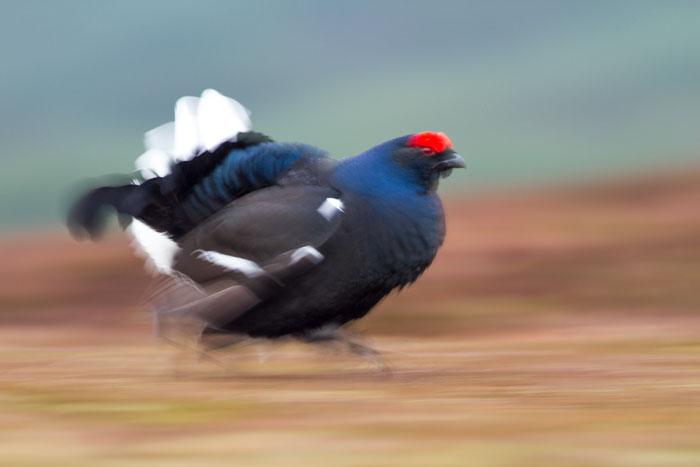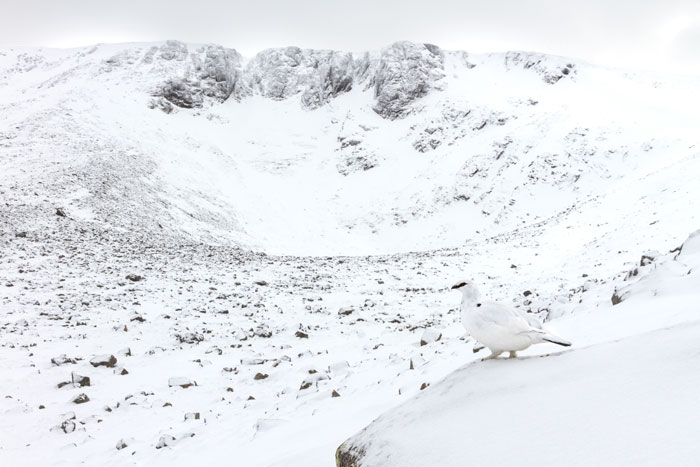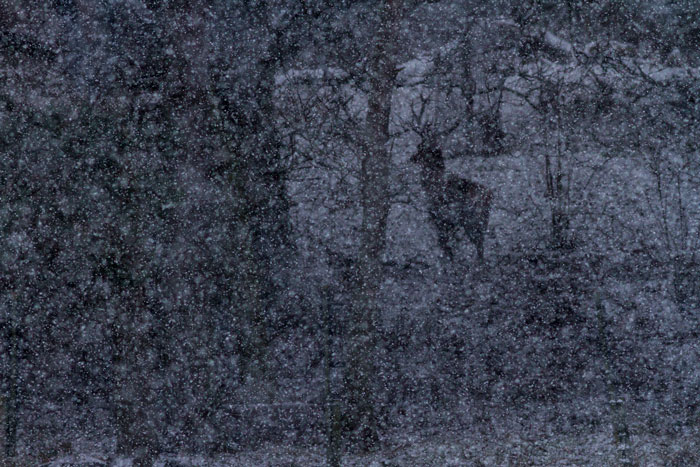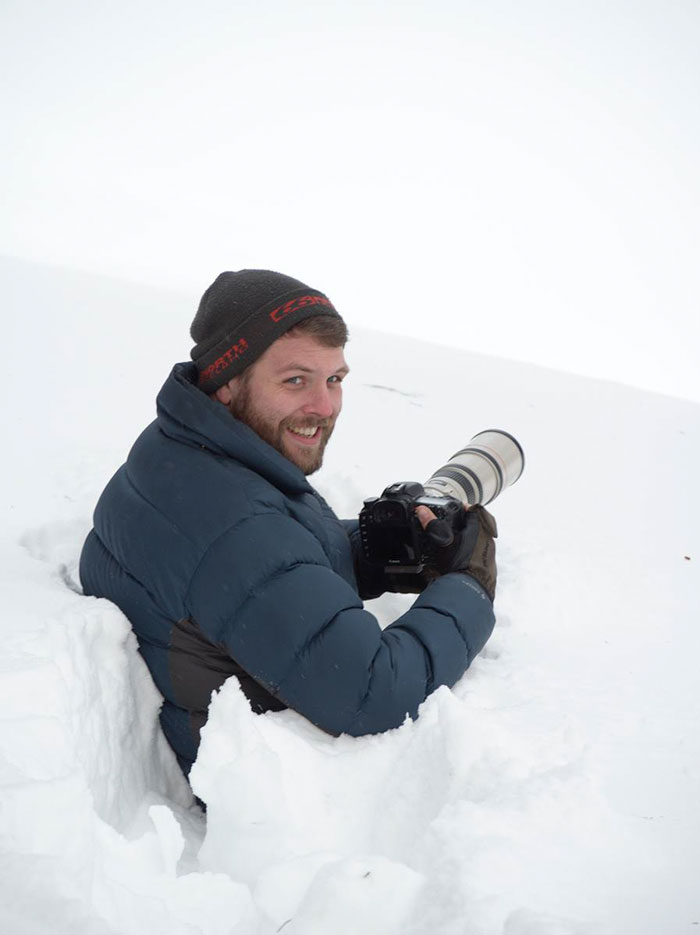Based in Cairngorms National Park in Scotland, nature photographer, filmmaker, and seasoned guide James Shooter has a passion for conveying the importance of nature conservation through an array of media outlets. James’ work is a reflection of the captivation he feels in his surroundings. He skillfully captures unique and unexpected moments of wildlife in their natural habitats. With a multifaceted approach, James compellingly advocates for the environment through mindful observation. As you browse through his photographs below, I think you’ll agree that he’s quite accomplished at his craft.
James, thank you so much for sharing all of your thoughtful responses with us. I enjoy viewing your photographs and I can’t wait to see more exceptional work from you in the future.
If you’d like to learn more about James, please visit his website. You can also follow him on Instagram.

Can you please tell the readers a bit about yourself?
I’m a nature photographer and filmmaker based in the Cairngorms National Park in Scotland. I’m a Director of SCOTLAND: The Big Picture, a rewilding advocacy and communications organisation, and lead wildlife photography holidays for Natures Images.
Where is home?
The Cairngorms National Park in Scotland.
What inspired you to be a photographer and a filmmaker?
I think the age-old answer of falling in love with David Attenborough’s nature documentaries. They inspired me so much growing up and I yearned to be a wildlife cameraman. After studying photography and filmmaking at university, I actually preferred still photography to film work. I loved trying to capture a story in a single moment.
What is the easiest part of your job?
Pressing the shutter button! Everything up to that part is planning for it. Studying maps and the way the light may hit the land, keeping an eye on unreliable weather forecasts, learning about an animal’s behaviour. The easiest part, and most enjoyable, is being in front of your scene, taking it all in, and capturing the moment.
What is the most challenging part of your job?
Probably trying to juggle several different aspects of a nature photography business at once. There are very few nature photographers that just take photographs nowadays. I lead photography holidays and nature-watching holidays, I run a series of wildlife photography hides, I guide wildlife photographers to find particular species on day guides, I produce and edit films, I’m a CAA approved drone pilot, I design communications materials, I run a couple of social media accounts, I’m a director of a social enterprise, and I take photos!
Locations and weather conditions seem to be a crucial aspect of a successful photograph. How do you handle these unpredictable factors?
I learned long ago that if you wait for perfect weather conditions, you don’t take photos!
Being adaptable is key, and some of my favourite shots have been taken in less than ideal weather conditions; conditions I may not have made myself go out in if it weren’t for a necessary reason. If it’s raining, wait for your animal to shake off the excess water, if it’s dull light, do some slow-shutter panning, if it’s snowy, hallelujah! You’ve hit gold!
What is your favorite animal to photograph and do you have any specific strategies for photographing them?
I’m a big fan of photographing red deer stags in the snow. There’s something quite regal about them and if you add snow into the midst it becomes quite magical. I also love to photograph ptarmigan, a small grouse that lives at the tops of the highest peaks in Scotland. These tough little birds turn all white in winter to match their surroundings, and the simplicity can create some beautiful images. Ptarmigan can be quite flighty, so you need to take your time and use the various boulders that make up their habitat to creep up behind.

Do you have a wish-list of shots you still want to get, maybe an animal that has eluded you?
Black woodpecker has been on my “to see” list since I first saw one in a European bird book – it’s eluded me several times whilst in the Pyrenees. One of my real targets would be to photograph a stoat in their white winter coat. I have many images of both mountain hare and ptarmigan during the winter months, which are camouflaged too, but I’ve never even seen a stoat at this time of year, so I’m desperate to complete the set!
How did you develop your style?
I never had a huge budget for photography equipment so I always called my style “forced creativity”. During university, I spent five weeks photographing in the Scottish Highlands every day. The weather was very unpredictable and if you didn’t adapt, you didn’t shoot. My camera couldn’t handle low light very well, so instead of fighting against high ISOs that would render my images noisy, I worked with the available light and got a bit creative with slower shutter speeds.
Equally, top quality telephoto lenses are megabucks! But if you can get really close to your subjects, a fair priced wide-angle can produce a good quality image. This is the style I really love – wide-angle wildlife photography. Getting up close and personal and combining wildlife with the landscape behind.
What is your favorite part of heading out to a new location?
The excitement of not knowing what you might find. You can always have a plan, but some of the best images are off the cuff when you just react to a particular scene that develops in front of you.
Photographers know that being successful is a combination of having the right equipment, as well as knowing how and when to use it and then having a creative photographic vision. You have photographed an array of animals that have been photographed by thousands of individuals, yet you seem to be able to capture brief moments with unique moods and emotions. How do you ensure this constant creativity?
I think every photographer has started out by taking the more common shots of wildlife. But once you’ve taken a few safe images, it’s time to develop and go beyond a standard portrait. There’s so much good quality content out there nowadays that’s so easily shared on social media, there’s little point in trying to take the same as everyone else. It wouldn’t inspire me if I took a shot that I knew many others had already taken, and probably better than I had! So I try to think how I might represent something a bit differently. Sometimes that’s just trying a different (usually shorter) lens and incorporating the environment. When you bring in the landscape, there are many more elements to the scene, which will make your image more unique.
Which is your favorite image? Could you explain the background story behind it?
Tough one! My favourite image is probably one that I took many years ago now. I set off to photograph red deer in the snow and had a particular type of image in mind. Once I got that photo of a stag staring through falling snow, I set about seeing what else I could capture. As I was coming up to a woodland glade, I saw the very faint outline of a stag through the thick snow. It was low light which cast a blue-tone to the image and I had to drop to the ground and quickly fire off a couple of shots before the deer moved and the shape was lost to the wood.

What do you hope viewers take away from your images?
I like images that make your eyes work. I hope that, at least for some of my photos, people have to pause and look for a while. I hope they get a sense of place and take in some of the story, rather than just looking at a pretty picture.
Do you have any tips for aspiring nature photographers?
Get out as much as possible. It really is the only way to get something different. Don’t get obsessed with long lenses and force yourself to try and capture something uniquely. Leave your expensive long lens at home on a few sessions and see what you can get with your wide-angle or medium telephoto. Get out of your comfort zone and see what you can create!
What type of camera(s) do you shoot with? What is your favorite lens?
I still use an old Canon 7D mark I for the vast majority of my stills, coupled with a 400mm 5.6 prime and a 15-85mm. It’s very old technology now, but I’ve made it work for my photography career so far! I also use a Panasonic GH5 for filming and a DJI Inspire 2 for aerial work.
What is your favorite photography accessory?
An app called the Photographers Ephermeris 3D. It’s so useful in planning shoots, especially aerials. You can plug in any location, set a date, and it will show you where the light will land and from which direction whilst taking into account the topography of the land. I couldn’t recommend this enough.
Do you use Photoshop, Lightroom, or any other software programs for post-processing your images?
I use Lightroom for the vast majority of my photo editing.
What is your digital darkroom process from when you download your files until you display them?
Usually, a very simple process working down the intuitive features on Lightroom. Balance the exposure and bring out some contrast and clarity, and then boost the vibrancy to a natural finish. For wildlife, I sometimes go in with a local adjustment and bring out some extra clarity and detail on the subject itself to make it pop a little more. Most images I can edit in under a minute, if it takes me any longer than three then I’ve done something wrong!
What are your thoughts on raw images vs images that have been edited?
All RAW images need to be edited. This type of shooting strips back a photo and gives a very bland finish, but with all the information needed. If you shoot in JPEG, the image is still edited, but it’s how the camera thinks it should look. By shooting in RAW and editing it yourself, you’re taking control of that process. I’m not keen on adding or taking away elements in photoshop apart from dust spots and minor distractions.
Can you tell me about one of your favorite or most memorable photo sessions? What made it so great and why did you like it so much?
One of my most memorable was probably photographing a bobcat in Yellowstone National Park. We’d been up and down the Madison River several times that week looking for an individual that had been seen hunting ducks. One afternoon we had a tantalising glimpse, and then on the final day it all came good and we had a short but exhilarating chance to photograph this beautiful species. The photos probably don’t do it justice, but it’s all about the experience for me. That’s why I take photos because I love spending time in nature. The photos are a bonus, but the experience itself will always be the most important part for me. If you’re passionate about something like that, the photos usually come good anyway.
Do you have any projects that make you look back and shake your head? What made the experience so unpleasant?
Trying to photograph Little Owls in the Peak District National Park was a challenge! I spent far too long sat in a tiny little makeshift hide waiting for these charismatic birds to make an appearance, and they always outfoxed me! I think I got one good shot and it wasn’t even a particularly nice place to sit and wait as I was camped out on a farm track and the sun was beating down on the nylon cover of my hide.
Do you have any new projects coming up or plans to expand your portfolio?
I’m always keen to try and work more on my portfolio of wide-angle wildlife images. These are my favourite type of photographs to try and create as they usually end up the most unique. I like the idea of trying to get different wildlife species in front of some of my favourite views. I’ve captured a few shots like this so far, but I’ve got to try and do some more soon.
What do you think the future holds for you? Where do you see yourself in the next few years?
I think from a business perspective, my focus will continue to be more on filming and guiding, as there’s still a living to be made in these areas. Which to be honest, it is great, as it means wildlife photography will become more of a hobby again, the pressure will lift and I’ll just enjoy being out with my camera – which is probably the purest form of photography there is!

Leave a Reply